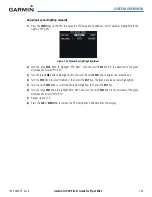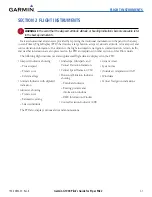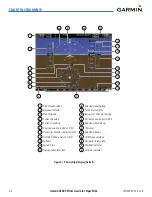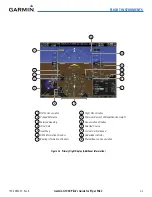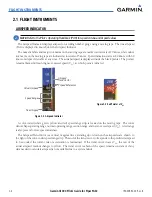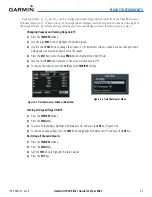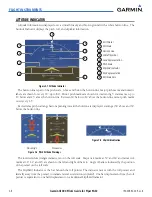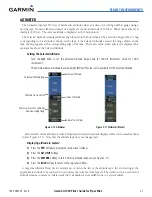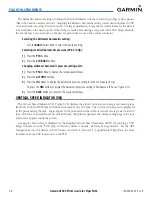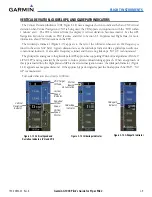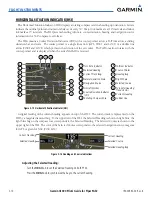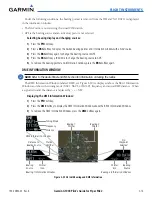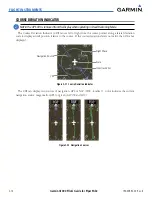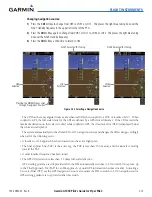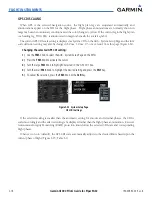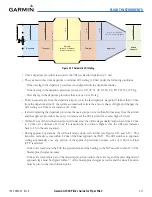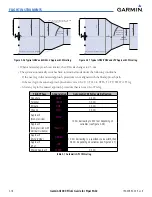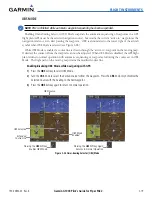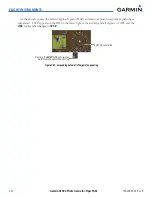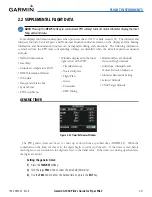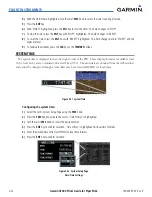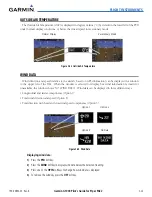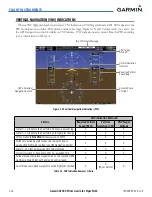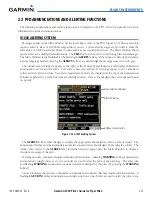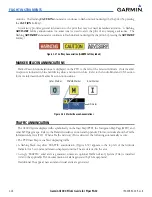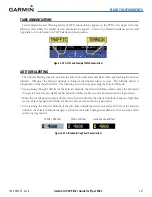
Garmin G1000 Pilot’s Guide for Piper PA32
190-00692-00 Rev. B
2-12
FLIGHT INSTRUMENTS
TURN RATE INDICATOR
The Turn Rate Indicator is located directly above the rotating compass card. Tick marks to the left and right
of the lubber line denote half-standard and standard turn rates. A magenta Turn Rate Trend Vector shows the
current turn rate. The end of the trend vector gives the heading predicted in 6 seconds, based on the present
turn rate. A standard-rate turn is shown on the indicator by the trend vector stopping at the standard turn
rate tick mark, corresponding to a predicted heading of 18˚ from the current heading. At rates greater than
4 deg/sec, an arrowhead appears at the end of the magenta trend vector and the prediction is no longer valid
(Figure 2-19).
Figure 2-19 Turn Rate Indicator and Trend Vector
Half-std Turn Rate
Std Turn Rate
Arrow Shown for
Turn Rate > 4 deg/sec
BEARING POINTERS AND INFORMATION WINDOWS
NOTE:
Refer to the Audio Panel and CNS Section for information on tuning the radios.
NOTE:
Distances in the Bearing Information windows and GPS bearing pointers turn yellow when operating
in Dead Reckoning Mode.
Two bearing pointers and associated information can be displayed on the HSI by pressing the
PFD
Softkey
then a
BRG
Softkey. Use the
BRG
Softkey to cycle through bearing sources (NAV, GPS, ADF). The pointers
are light blue and are single- (BRG1) or double-lined (BRG2); an icon is shown in the respective information
window to indicate the pointer type. The bearing pointers never override the CDI and are visually separated
from the CDI by a white ring (shown when bearing pointers are selected but not necessarily visible due to
data unavailability).
When a bearing pointer is displayed, its associated information window is also displayed. The Bearing
Information windows (Figure 2-20) are displayed to the lower sides of the HSI and show:
• Bearing source (NAV, GPS, ADF)
• Pointer icon (single line for BRG1, double line for BRG2)
• Frequency (NAV, ADF)
• Station/waypoint identifier (NAV, GPS)
• GPS-derived great circle distance to bearing source
If the NAV radio is the bearing source and is tuned to an ILS frequency, the bearing pointer is removed from
the HSI and the frequency is replaced with “ILS”. When NAV1 or NAV2 is the selected bearing source, the
frequency is replaced by the station identifier when the station is within range. If GPS is the bearing source,
the active waypoint identifier is displayed in lieu of a frequency.
Summary of Contents for G1000:Piper
Page 1: ...Piper PA32...
Page 50: ...190 00692 00 Rev B Garmin G1000 Pilot s Guide for Piper PA32 1 40 SYSTEM OVERVIEW BLANK PAGE...
Page 438: ...190 00692 00 Rev B Garmin G1000 Pilot s Guide for Piper PA32 D 6 APPENDIX D BLANK PAGE...
Page 444: ...190 00692 00 Rev B Garmin G1000 Pilot s Guide for Piper PA32 F 4 APPENDIX F BLANK PAGE...
Page 450: ...Garmin G1000 Pilot s Guide for Piper PA32 190 00692 00 Rev B I 6 INDEX BLANK PAGE...


